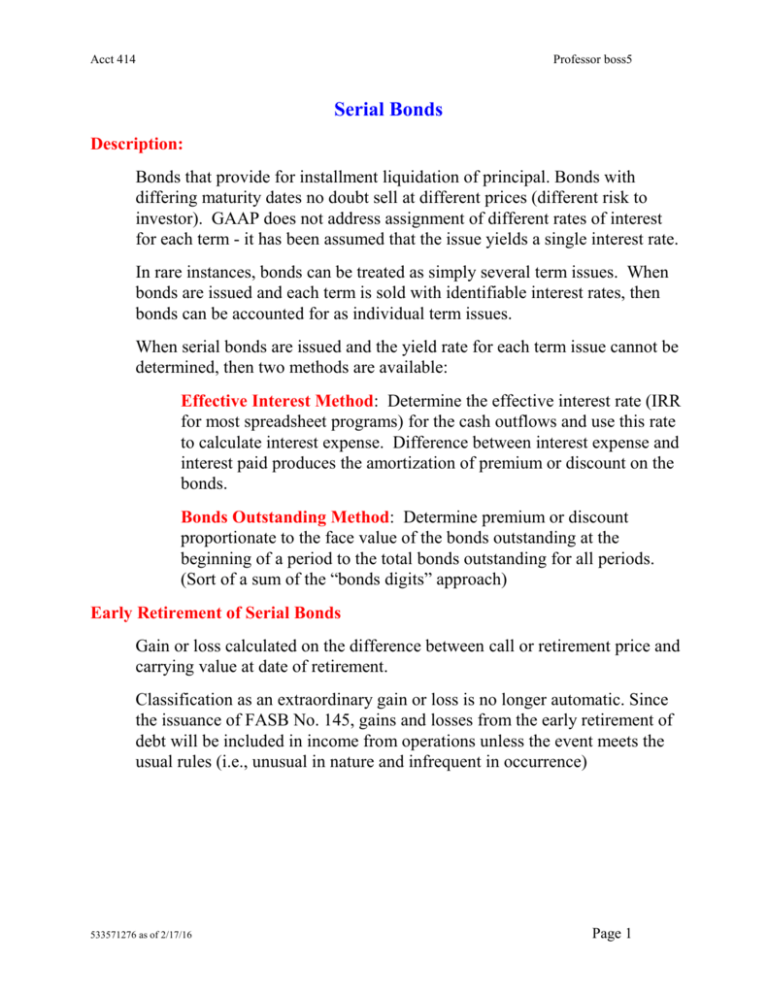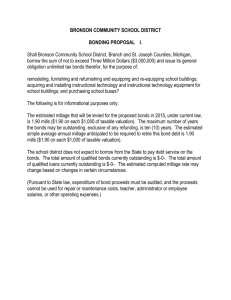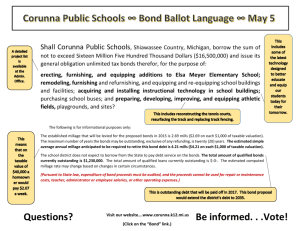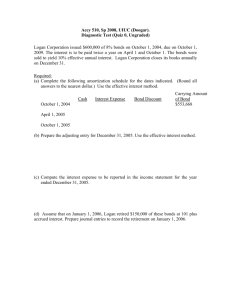Serial Bonds: Accounting Methods & Examples
advertisement

Acct 414 Professor boss5 Serial Bonds Description: Bonds that provide for installment liquidation of principal. Bonds with differing maturity dates no doubt sell at different prices (different risk to investor). GAAP does not address assignment of different rates of interest for each term - it has been assumed that the issue yields a single interest rate. In rare instances, bonds can be treated as simply several term issues. When bonds are issued and each term is sold with identifiable interest rates, then bonds can be accounted for as individual term issues. When serial bonds are issued and the yield rate for each term issue cannot be determined, then two methods are available: Effective Interest Method: Determine the effective interest rate (IRR for most spreadsheet programs) for the cash outflows and use this rate to calculate interest expense. Difference between interest expense and interest paid produces the amortization of premium or discount on the bonds. Bonds Outstanding Method: Determine premium or discount proportionate to the face value of the bonds outstanding at the beginning of a period to the total bonds outstanding for all periods. (Sort of a sum of the “bonds digits” approach) Early Retirement of Serial Bonds Gain or loss calculated on the difference between call or retirement price and carrying value at date of retirement. Classification as an extraordinary gain or loss is no longer automatic. Since the issuance of FASB No. 145, gains and losses from the early retirement of debt will be included in income from operations unless the event meets the usual rules (i.e., unusual in nature and infrequent in occurrence) 533571276 as of 2/17/16 Page 1 Acct 414 Professor boss5 Serial Bond Example: NQK Inc. issues $100,000 face value of semi-annual bonds with stated interest rate of 12% on January 1, 20X1. Principal in the amount of $20,000 will be repaid each year beginning 12/31/X1 until the bonds are fully retired. Interest is paid on June 30 and December 31 of each year. The amount received from Investment Banker is $95,409. Stated interest rate Yield rate Total face value Face value per year Bond period in years Interest payments per year Proceeds of bond issue 12% ? 100,000 20,000 5 2 95,409 For the effective interest method, the first step is to determine the effective interest rate. How can we do this? Is it an ordinary annuity problem? Cash flows: Period Interest Paid Principal Re-paid Cash Flow 0 1 2 3 4 5 6 7 8 9 10 533571276 as of 2/17/16 Page 2 Acct 414 Professor boss5 Effective Interest Amortization - Serial Bond Period Interest Paid Principal Repaid Interest Expense Amount Amortized Carrying Value of Bonds 0 1 2 3 4 5 6 7 8 9 10 533571276 as of 2/17/16 Page 3 Premium or Discount Balance Face Value of Bonds Outstanding Acct 414 Professor boss5 Bonds Outstanding Amortization - Serial Bonds Period Interest Paid Principal Re-paid Interest Expense Amount Amortized Carrying Value of Bonds Premium or Discount Balance 0 1 2 3 4 5 6 7 8 9 10 533571276 as of 2/17/16 Page 4 Face Value of Bonds Outstanding Amortization Fraction Acct 414 Professor boss5 Solution for Example Problem EFFECTIVE INTEREST AMORTIZATION SCHEDULE 6.00% Period Date Interest Principal Paid Payment 0 01/01/01 0 1 06/30/01 6,000 2 12/31/01 6,000 20,000 3 06/30/02 4,800 4 12/31/02 4,800 20,000 5 06/30/03 3,600 6 12/31/03 3,600 20,000 7 06/30/04 2,400 8 12/31/04 2,400 20,000 9 06/30/05 1,200 10 12/31/05 1,200 20,000 11 06/30/06 0 Journal entries: 7.000% Interest Expense 0 6,679 6,726 5,377 5,417 4,061 4,093 2,727 2,750 1,375 1,387 0 Face Value: 100,000 Carrying BALANCE Value DISCOUNT 0 95,409 (4,591) (679) 96,088 (3,912) (726) 76,814 (3,186) (577) 77,391 (2,609) (617) 58,008 (1,992) (461) 58,468 (1,532) (493) 38,961 (1,039) (327) 39,288 (712) (350) 19,638 (362) (175) 19,813 (187) (187) 0 0 (0) 0 0 Amortization FACE VALUE 100,000 100,000 80,000 80,000 60,000 60,000 40,000 40,000 20,000 20,000 0 0 Effective Interest Method 01/01/01 Cash Discount on Bonds Payable Bonds Payable Debit 95,409 4,591 100,000 06/30/01 Interest Expense Discount on Bonds Payable Cash 6,679 12/31/01 Interest expense Bonds Payable Discount on Bonds Payable Cash 6,726 20,000 679 6,000 726 26,000 133,405 533571276 as of 2/17/16 Credit Page 5 133,405 Acct 414 Professor boss5 Serial Bond Example Bonds Outstanding Method Comments: The amortization fraction is determined based on total principal outstanding at each interest payment date. It is similar to sum of the years digits depreciation.. Note that the first fraction is 100/600 and the last fraction is 20/600. With this method, we do not need to know the effective interest rate. Before calculators and spreadsheets, the bonds outstanding method was the only efficient way to handle a serial bond! Period 0 1 2 3 4 5 6 7 8 9 10 Date 01/01/01 06/30/01 12/31/01 06/30/02 12/31/02 06/30/03 12/31/03 06/30/04 12/31/04 06/30/05 12/31/05 Journal entries: 6.00% Interest Paid 6,000 6,000 4,800 4,800 3,600 3,600 2,400 2,400 1,200 1,200 Principal Payment 20,000 20,000 20,000 20,000 20,000 Interest Expense 6,765 6,765 5,412 5,412 4,059 4,059 2,706 2,706 1,353 1,353 Amortization (765) (765) (612) (612) (459) (459) (306) (306) (153) (153) Face Value: Carrying Value 95,409 96,174 76,939 77,551 58,164 58,623 39,082 39,388 19,694 19,847 0 FACE VALUE 100,000 100,000 80,000 80,000 60,000 60,000 40,000 40,000 20,000 20,000 0 600,000 Bonds Outstanding Method 01/01/01 Cash Discount on Bonds Payable Bonds Payable Debit 95,409 4,591 Credit 100,000 06/30/01 Interest Expense Discount on Bonds Payable Cash 6,765 12/31/01 Interest expense Bonds Payable Discount on Bonds Payable Cash 6,765 20,000 765 6,000 133,530 533571276 as of 2/17/16 100,000 BALANCE DISCOUNT (4,591) (3,826) (3,061) (2,449) (1,836) (1,377) (918) (612) (306) (153) - Page 6 765 26,000 133,530 Amortization Fraction 10/600 = 0.16667 10/600 = 0.16667 80/600 = 0.13333 80/600 = 0.13333 60/600 = 0.10000 60/600 = 0.10000 40/600 = 0.06667 40/600 = 0.06667 20/600 = 0.03333 20/600 = 0.03333








